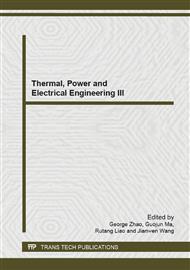[1]
YingchuTao. A new type steel pickling inhibitor (LK45 phytic acid extract) for cleaning scale of boiler[J]. Materials Protection, 1987, 28(4): 26-30(In Chinese).
Google Scholar
[2]
Zhihu Guo,Heqing Tan. Inhibitive Effects of Extracts of Some Plants on the Corrosion of Carbon Steel[J]. Materials Protection, 1989, 22(2): 9-12(In Chinese).
Google Scholar
[3]
Zheng Lin. On Effects of Some Plant Corrosive Inhibitorson Cathodic Polarization of Steel[J]. Journal of Fuzhou University(Natural Science), 1999, 27(4): 108-110(In Chinese).
Google Scholar
[4]
Wanyou Zhang, ,Yuefang Chen,XunLi. Inhibitive Effect of Some Natural-occuring Substance on Dissolution of A3 Steel in HCl Solution[J]. North China electric power, 2002, 1: 9-15(In Chinese).
Google Scholar
[5]
Zheng Liu, Gen liang Xiong. Preparation and application of plant inhibitors. Corrosion and Protection, 2003, 24(4): 146-149(In Chinese).
Google Scholar
[6]
Xiu-zhou Lin, Min Gong, Jianping Wu. Study about use of abstracted oil from plant scrap as corrosion-inhibitor for hydrochloric acid cleaning. Corrosion science and protection technology, 2006, 18(3) : 222-225(In Chinese).
Google Scholar
[7]
Yan Li, Peng Zhao, Baorong Hou. Corrosion inhibition of mild steel by goldthread extractive in 1mol/L HCl solutions. Corrosion science and protection technology, 2006, 18(1):1-3(In Chinese).
Google Scholar
[8]
Xiang-Hong Li,Shu-Duan Deng,Hui Fu. Inhibition by Jasminum nudiflorum Lindl leaves extract of the corrosion of cold rolled steel in hydrochloric acid solution. J Appl Electrochem, 2010, 40: 1641–1649(In Chinese).
DOI: 10.1007/s10800-010-0151-5
Google Scholar
[9]
R M Salch. Corrosion inhibition by naturally occurring substances: The effect aqueous extracts of some leaves and fruit peels on the corrosion of steel Al, Zn and Cu in acid [J]. British Corrosion Journal,1982, 17(3): 131-136(In Chinese).
DOI: 10.1179/000705982798274345
Google Scholar
[10]
I H Farooqi,A Hussain,M A Quraishi, et a1. Study of low cost ecofriendly compounds as corrosion inhibitors for cooling systems [J] . Anticorrosion Methods and Materials,1999,46(50) : 328-331.
DOI: 10.1108/00035599910295508
Google Scholar
[11]
K P Vinod Kumar,M. Sankara Narayanan Pillai,G. Rexin Thusnavis. Green corrosion inhibitor from seed extract of Areca catechu for mild steel in hydrochloric acid medium[J]. J Mater Sci, 2011, 46: 5208–5215.
DOI: 10.1007/s10853-011-5457-0
Google Scholar
[12]
A Minhale . The effect aqueous extracts of some leaves and fruit peels on the corrosion of steel in acid[J]. Corrosion Prevent ion and Control 1999, 4 : 32-35.
Google Scholar
[13]
G. Matamala. Comparison of steel anticorrosive protection formulated with natural tannins extracted from acacia and from pine bark[J] . Corrosion Science,2000, 42: 1351-1356.
DOI: 10.1016/s0010-938x(99)00137-7
Google Scholar
[14]
S Martinez,Stadjar I. Correlation between the molecular structure and the corrosion inhibition efficiency of chestnut tannin in acidic solutions[J]. Journal of Molecular Structure,2003, 640: 167-171.
DOI: 10.1016/j.theochem.2003.08.126
Google Scholar
[15]
YingHan, Weidong Run . Preparation of corrosion inhibitor from wild natural plant[J]. Chemical Engineer. 1994, 5: 48(In Chinese).
Google Scholar
[16]
Guanghua Zhang, Yang Li. Research on picking inhibitor made by hydrolysis of papeseed cake[J]. Fine Chemicals, 1996, 13(1) : 18.
Google Scholar
[17]
Hai-yan Du Xiao-hong, Peng, Yanfen, Zhang, Yan Gao. The process extraction amino acid from bean dregs and its corrosion mechanism. Anhui Chemical Industry, 2008, 34(3): 35-37.
Google Scholar
[18]
The determination of free amino acids content in tea[S]. National standard of the People's Republic of China. GB/T8314-(2002).
Google Scholar
[19]
Performance test methods and evaluation indexes of Corrosion Inhibitor for Acidification[S], The People's Republic of China oil and gas industry standards SY/T 5405-(1996).
Google Scholar
[20]
Water quality standard and practice for analysis of oilfield injecting waters in clastic reservoirs [S], The People's Republic of China oil and gas industry standards SY/T 5329-(2012).
Google Scholar
[21]
Corrosion of metals and alloys—Removal of corrosion products from corrosion test specimens[S]. National standard of the People's Republic of China GB/T16545-(1996).
DOI: 10.3403/30346599
Google Scholar


